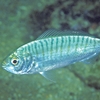General Description
Head large, strongly flattened, with prominent ridges, gill cover with two spines at angle, lower slightly larger than upper. Sandy to greyish or almost black above, sometimes with darker bars and pale spots or blotches, pale below. Upper part of tail covered in brown spots, lower half bluish grey, sometimes with a dark blotch in the middle; fin rays with rows of fine brown spots, pectoral fin densely covered in small brown to reddish-brown spots. To 1.2 m.
Biology
A very important recreational and commercial species in eastern Australia. Their fin spines are venomous.
Habitat
Shallow coastal waters, on soft bottoms in estuaries, bays and along the coast to depth of 79 m, although usually above 20 m.
Soft substrates
Distribution guide
Eastern Australia. In eastern Victoria and rarely central Victoria to Port Phillip.
Species Group
Depth
Shallow (1-30 m)
Deep ( > 30 m)
Water Column
Max Size
1.2 m
Diet
Carnivore
Harmful
Venomous spines can inflict mild to severe pain.
Commercial Species
Yes
Global Dispersal
Native to Australia
Identify
Conservation Status
- DSE Advisory List : Not listed
- EPBC Act 1999 : Not listed
- IUCN Red List : Not listed





